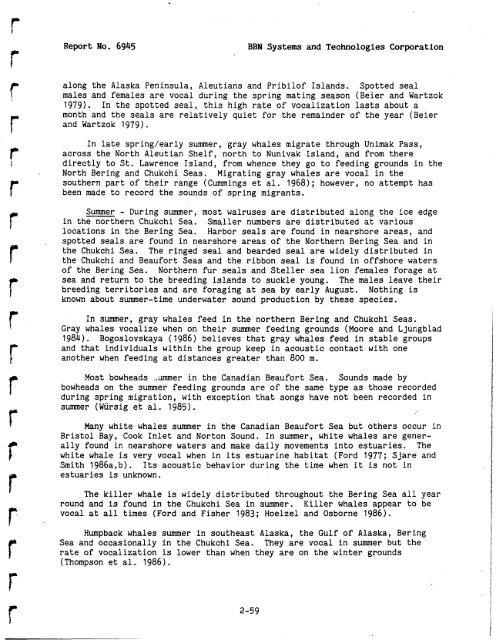Analysis and Ranking of the Acoustic Disturbance Potential of ...
Analysis and Ranking of the Acoustic Disturbance Potential of ...
Analysis and Ranking of the Acoustic Disturbance Potential of ...
You also want an ePaper? Increase the reach of your titles
YUMPU automatically turns print PDFs into web optimized ePapers that Google loves.
Report No. 6945<br />
BBN Systems <strong>and</strong> Technologies Corporation<br />
along <strong>the</strong> Alaska Peninsula, Aleutians <strong>and</strong> Pribil<strong>of</strong> Isl<strong>and</strong>s. Spotted seal<br />
males <strong>and</strong> females are vocal during <strong>the</strong> spring mating season (Beier <strong>and</strong> Wartzok<br />
1979). In <strong>the</strong> spotted seal, this high rate <strong>of</strong> vocalization lasts about a<br />
month <strong>and</strong> <strong>the</strong> seals are relatively quiet for <strong>the</strong> remainder <strong>of</strong> <strong>the</strong> year (Beier<br />
<strong>and</strong> Wartzok 1979).<br />
In late spring/early summer, gray whales migrate through Unimak Pass,<br />
across <strong>the</strong> North Aleutian Shelf, north to Nunivak Isl<strong>and</strong>, <strong>and</strong> from <strong>the</strong>re<br />
directly to St. Lawrence Isl<strong>and</strong>, from whence <strong>the</strong>y go to feeding grounds in <strong>the</strong><br />
North Bering <strong>and</strong> Chukchi Seas. Migrating gray whales are vocal in <strong>the</strong><br />
sou<strong>the</strong>rn part <strong>of</strong> <strong>the</strong>ir range (Cummings et al. 1968); however, no attempt has<br />
been made to record <strong>the</strong> sounds <strong>of</strong> spring migrants.<br />
Summer - During summer, most walruses are distributed along <strong>the</strong> ice edge<br />
in <strong>the</strong> nor<strong>the</strong>rn Chukchi Sea. Smaller numbers are distributed at various<br />
locations in <strong>the</strong> Bering Sea. Harbor seals are found in nearshore areas, <strong>and</strong><br />
spotted seals are found in nearshore areas <strong>of</strong> <strong>the</strong> Nor<strong>the</strong>rn Bering Sea <strong>and</strong> in<br />
<strong>the</strong> Chukchi Sea. The ringed seal <strong>and</strong> bearded seal are widely distributed in<br />
<strong>the</strong> Chukchi <strong>and</strong> Beaufort Seas <strong>and</strong> <strong>the</strong> ribbon seal is found in <strong>of</strong>fshore waters<br />
<strong>of</strong> <strong>the</strong> Bering Sea. Nor<strong>the</strong>rn fur seals <strong>and</strong> Steller sea lion females forage at<br />
sea <strong>and</strong> return to <strong>the</strong> breeding isl<strong>and</strong>s to suckle young. The males leave <strong>the</strong>ir<br />
breeding territories <strong>and</strong> are foraging at sea by early August. Nothing is<br />
known about summer-time underwater sound production by <strong>the</strong>se species.<br />
In summer, gray whales feed in <strong>the</strong> nor<strong>the</strong>rn Bering <strong>and</strong> Chukchi Seas.<br />
Gray whales vocalize when on <strong>the</strong>ir summer feeding grounds (Moore <strong>and</strong> Ljungblad<br />
1984). Bogoslovskaya (1986) believes that gray whales feed in stable groups<br />
<strong>and</strong> that individuals within <strong>the</strong> group keep in acoustic contact with one<br />
ano<strong>the</strong>r when feeding at distances greater than 800 m.<br />
Most bowheads .,ummer in <strong>the</strong> Canadian Beaufort Sea. Sounds made by<br />
bowheads on <strong>the</strong> summer feeding grounds are <strong>of</strong> <strong>the</strong> same type as those recorded<br />
during spring migration, with exception that songs have not been recorded in<br />
summer (Wiirsig et al. 1985).<br />
Many white whales summer in <strong>the</strong> Canadian Beaufort Sea but o<strong>the</strong>rs occur in<br />
Bristol Bay, Cook Inlet <strong>and</strong> Norton Sound. In summer, white whales are generally<br />
found in nearshore waters <strong>and</strong> make daily movements into estuaries. The<br />
white whale is very vocal when in its estuarine habitat (Ford 1977; Sjare <strong>and</strong><br />
Smith 1986a,b). Its acoustic behavior during <strong>the</strong> time when it is not in<br />
estuaries is unknown.<br />
.The killer whale is widely distributed throughout <strong>the</strong> Bering Sea all year<br />
round <strong>and</strong> is found in <strong>the</strong> Chukchi Sea in summer. Killer whales appear to be<br />
vocal at all times (Ford <strong>and</strong> Fisher 1983; Hoelzel <strong>and</strong> Osborne 1986).<br />
Humpback whales summer in sou<strong>the</strong>ast Alaska, <strong>the</strong> Gulf <strong>of</strong> Alaska, Bering<br />
Sea <strong>and</strong> occasionally in <strong>the</strong> Chukchi Sea. They are vocal in summer but <strong>the</strong><br />
rate <strong>of</strong> vocalization is lower than when <strong>the</strong>y are on <strong>the</strong> winter grounds<br />
(Thompson et a1 . 1986 ) .
















